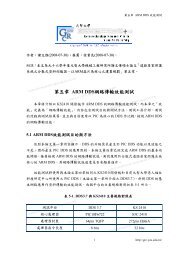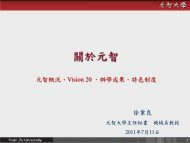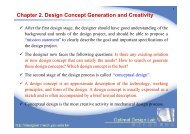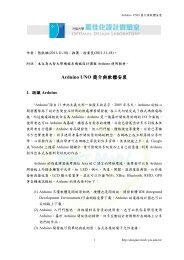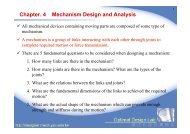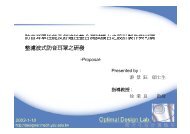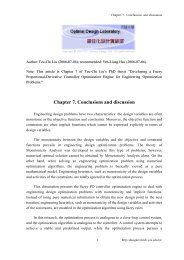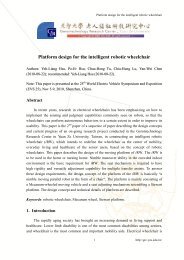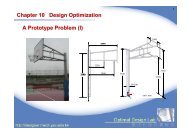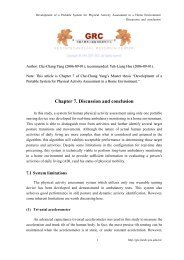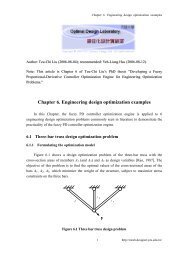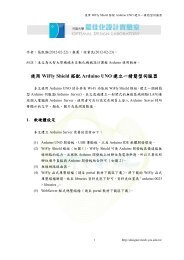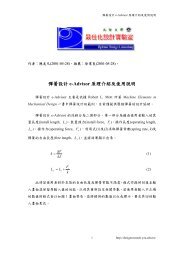PDF Version
PDF Version
PDF Version
You also want an ePaper? Increase the reach of your titles
YUMPU automatically turns print PDFs into web optimized ePapers that Google loves.
112 Yung-Chieh Hung and Yeh-Liang HsuFig. 3chuckhammermotorhammerchuckTop plan view of a hammer-type impact generatorTo eliminate the hammering noise, some patentshave proposed the concept of a magnetic impacttool with which screws are tightened using magneticcoupling to deliver a strike without any contact.A tightening rotational impact force is obtainedwithout a collision sound. The successful exampleof a magnetic impact tool is disclosed in US Patent6,918,449 [6]. As shown in Fig. 4, the magneticimpact tool comprises a magnetic hammer drivenby a motor, a magnetic anvil disposed so as to facethe magnetic hammer, and an output shaft thatrotates together with the magnetic anvil. Themagnetic hammer is movable with respect to themagnetic anvil without contact.A rotational impact force is magnetically generatedin a non-contact manner for the magneticanvil in conjunction with the rotation of themagnetic hammer. During the screw tighteningwork, for example, when the load torque is initiallylow, the magnetic hammer and magnetic anvil beginto rotate together without any impact action. Whenthe load torque exceeds the magnetic attractiontorque, the magnetic hammer and magnetic anvilare no longer synchronized. Impact action can begenerated, and screw tightening and looseningwork can be carried out even if a low-torque motoris used.The torque generated between the magnetichammer and magnetic anvil can be changed by thechanging device to vary the distribution ratio ofthe magnetic flux from the magnetic hammer tothe magnetic anvil. As shown in Fig. 4, there isa magnetic bypass device for distributing magneticflux between the magnetic anvil and the magnetichammer. There is also a changing device for changingthe distribution of magnetic flux. The changingdevice comprises a micromotor (25a), a worm gear(25b), and a pinion gear (25d). The pinion gear ismounted on the external peripheral surface of thebypass device (24a). The bypass device can bemoved in a reciprocating manner in the axialdirection of the driveshaft by driving the micromotor.Thus, the distribution of magnetic fluxbetween the magnetic hammer and magnetic anvilcan be changed. A switch for controlling the operationof the micromotor may be provided separately.A standard design-around approach is first appliedto US Patent 6,918,449. Nydegger and Richards [3]summarized the process of designing aroundpatents as follows.Step 1. To search related patents.Step 2. To develop the abstract list for each concernedpatent.Step 3. To check whether each element of a claim of theselected patent in the second step is necessary or not.Step 4. To inspect whether limitations of terms existin the elements.Step 5. To examine if there are potential disadvantagesor other characteristics existing in the coretechniques owing to the generation of some functionor specific effects in the patented invention.Step 6. To try to use various approaches of implementationto have substantially different functions.Step 7. To compare the results from design-aroundand the objective patent.In this research, US Patent 6,918,449 is the target fordesign-around (step 1). There are seven technologicalcharacteristics in the independent claim ofthis patent (step 2):(a) a motor for generating rotational force;(b) a driveshaft rotatably driven by the motor;(c) a magnetic hammer rotatably moved in acoupled state with the driveshaft;(d) a magnetic anvil that faces the magnetichammer and to which the rotational force istransmitted by magnetic coupling, with one ofthe opposing surfaces of the magnetic hammerand magnetic anvil having a magnetic pole,and the other having a magnetic pole ormagnetic body;(e)(f)(g)an output shaft rotated by the magnetic anvil;a magnetic bypass device that bypasses themagnetic flux between the magnetic anvil andthe magnetic hammer, and changes the stateof magnetic coupling there between;a changing device that changes the bypassquantity of the magnetic flux with the magneticbypass device, with the torque transmitted fromthe magnetic hammer to the magnetic anvilbeing changed in accordance with the changein bypass quantity of the magnetic flux variedby the changing device.For steps 3 to 5, the technology/function matrix of USPatent 6,918,449 is constructed as in Table 1, in orderto investigate the techniques that can produce thespecific functions. For example, in the third columnProc. IMechE Vol. 221 Part B: J. Engineering Manufacture JEM667 Ó IMechE 2007



